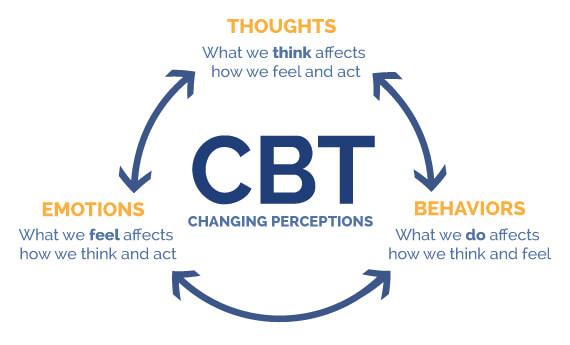Unlocking Emotional Well-being: Unveiling 3 Cognitive Distortions that Impact Your Happiness & Make You Miserable
It’s common for us to blame external sources for our mental condition when we’re experiencing one or more of the emotions like stress, depression, anger, or helplessness.
However, recent research suggests that it’s often our irrational thoughts that fuel these intense feelings, rather than external circumstances. Surprisingly, we may not even be aware of the specific thought patterns contributing to our distress.
Enter Dr. Albert Ellis, one of the esteemed pioneers of Cognitive Behavioral Therapy (CBT). CBT is an effective therapeutic approach for managing various issues by reshaping our thoughts and behaviors. Although commonly associated with treating anxiety and depression, CBT can also address other mental and physical health concerns.
Dr. Ellis identified three distinct types of thinking that commonly disturb individuals. Coining the term “MUST-erbating,” he recognized that all these cognitive distortions involve the word “must.” By becoming familiar with these irrational thought patterns, you can proactively replace them with healthier alternatives, leading to enhanced tranquility, joy, and the ability to tackle challenges without succumbing to a sense of helplessness. Let’s embark on a journey towards emotional well-being and start experiencing life to the fullest.
Let’s learn more about below points in depth ( tap / click to jump to the respective topic )
1. What are the “3 MUST”, which are making your life miserable every day ?
4. Conclusion
What are the “3 MUST”, which are making your life miserable every day ?
Let’s engage in an enlightening exercise to understand the concept of happiness snatchers that often invade our lives. Take a moment to recall your most recent upsetting incident and grab a piece of paper to jot it down.
Pour your thoughts onto the paper – why exactly did it upset you? What transpired during that incident?
Enter Dr. Albert Ellis, the renowned American psychologist who laid the foundation for rational emotive behavior therapy (REBT), often considered the predecessor of Cognitive Behavioral Therapy (CBT).
Dr. Ellis’s groundbreaking theory revolves around identifying three pivotal “MUSTs” that tend to contribute to emotional distress.
CBT, at its core, seeks to transform these thinking patterns to foster improved mental health. The “MUSTs” represent rigid, absolute beliefs individuals hold about themselves, others, and the world.
Dr. Ellis’s theory delineates three primary “MUSTs”:
Must 1 ( Thinking Enemy No. 1 ) : I must do well and be approved of by everyone I meet or else I’m no good.
Must 2 ( Thinking Enemy No. 2 ): Others must treat me fairly and kindly and always consider my feelings. If they do not treat me this way, they are not good people and deserve to
be punished.
Must 3 ( Thinking Enemy No. 3 ): I must always get what I want; when I want it, and if I don’t I’m miserable.
These 3 MUST form the core of a belief system that vehemently opposes the reality of life as it is.
Succumbing to such thinking breeds anxiety, depression, and anger.
However, by delving into Dr. Ellis’s transformative system, you can embark on a journey towards a happier, healthier mindset, liberating yourself from the clutches of this detrimental thought process.
What are the 5 Steps of CBT ? Unlocking the Power of CBT, A Comprehensive Guide to the 5 Steps of Cognitive Behavioral Therapy
Embarking on a journey of self-discovery and personal growth begins with unraveling the intricate web of thoughts that shape our emotions and behaviors. Cognitive Behavioral Therapy (CBT) serves as a guiding light, providing a concrete system to identify and transform these thoughts. Let’s explore the transformative power of CBT through its five fundamental steps.
Step 1: Identify the Belief
The first step in CBT involves cultivating self-awareness to recognize the thoughts that contribute to our emotional distress. Take a moment to reflect on your original problem and examine whether it aligns with any of the three common thinking patterns associated with cognitive distortions. This introspective exploration lays the foundation for positive change.
Your problem of any kind always falls under one of the 3 MUSTs mentioned above. It’s very important to categorize it first, before moving ahead.
Step 2: Challenge the Belief
Once the beliefs contributing to negative emotions are identified, the next step is to challenge their validity. CBT empowers you to critically evaluate these beliefs, questioning their accuracy and examining the evidence supporting or refuting them. By challenging the distorted thoughts, you can weaken their hold on your emotional well-being.
Ask yourself questions like, “Do I have evidence that I must be approved by everyone? Is it realistic that everyone should like me?” Is it really true that everyone must think poorly of you because you may have overshared in a conversation? Could it be possible that they are not judging you as harshly as you think? Are you being fair to yourself by assuming the worst-case scenario?
How would you feel if someone else had had this thought about themselves after a conversation with you? Would you automatically judge them negatively, or would you try to be understanding and supportive? And then then you could also ask yourself, as you challenge this belief, like, “How does this belief affect me? What are the consequences of holding this belief?” So these are a bunch of ways to challenge your thoughts,
So check out your thoughts from your paper, and see, like, how can you challenge this thought?
Step 3: Replace the Belief
Having recognized the flaws in your negative beliefs, it’s time to replace them with healthier alternatives. CBT equips you with effective strategies to develop new, adaptive beliefs that promote positive emotions and constructive behaviors. This process involves reframing your perspective and cultivating a more balanced outlook on yourself, others, and the world around you.
If you were worried about your last experiences in book club, then you can do the below.
Choose something that’s more realistic or helpful. So you might say, “It’s okay if I overshared in the conversation, as long as I didn’t harm anyone.” “I can learn from this experience. I can be more mindful in future conversations.”
Or you can think, “Oh, it’s not my responsibility to control how others think or feel about me. I can only be true to myself, and I can trust that others will respect and appreciate me for who I am.”
You could say, “Oh, I can give myself credit for being open and honest in the conversation, for having the courage to share my thoughts and feelings, and this can help me connect with others on a deeper level, and I admire that trait in other people.”
So we replace that belief with, like, okay, this is more helpful. So now that we’ve challenged those thoughts and replaced them,
Step 4: Practice New Behaviors
Shifting your thoughts is only part of the equation. To solidify the transformation, it’s crucial to engage in new behaviors that align with your revised beliefs. CBT encourages the implementation of practical actions that reinforce your newfound perspective. By consistently practicing these behaviors, you strengthen your resilience, enhance self-confidence, and foster positive change in your life.
If you’re afraid of going to book club as you may think what others will think of you then don’t stop going to social activities, continue to express yourself, and, you know, stop yourself from ruminating about social experiences.
Step 5: Monitor and Celebrate Progress
The final step in the CBT journey involves monitoring your progress and celebrating even the smallest victories. Regularly assessing your thoughts, emotions, and behaviors allows you to gauge the effectiveness of the therapeutic process. Recognize the milestones you’ve achieved, no matter how minor they may seem, and acknowledge your growth. This positive reinforcement reinforces your commitment to the CBT principles and fuels continued progress.
Watch yourself for any signs of success. Are you developing closer relationships with your friends because you’re sharing about yourself? Are you starting to feel more confident? Are you starting to look forward to book club because you enjoy the good conversations or you just, you know, like getting out of the house? And, you know, after a social activity are you being nicer to yourself?
Paying a lot of attention to positive outcomes actually increases dopamine and motivation. It’s an essential part of the feedback loop, and it helps you be more motivated to challenge your thinking in the future and to do more activities that line up with the life that you want to live.
Pretty soon the new belief system can become automatic and habitual.
By embracing these five transformative steps, CBT empowers you to take control of your thoughts, emotions, and actions. Unlocking the full potential of CBT paves the way for personal growth, emotional resilience, and a brighter future filled with renewed well-being.
Let’s learn from one of the best everyday examples; which keeps on making everyone’s life miserable
Mastering Anger on the Road: Unleashing the Power of Cognitive Shifts
Have you ever found yourself seething with anger while driving?
Do thoughts like “Everyone is a terrible driver, and they need to get off the road!” consume your mind? Let’s identify the underlying “MUST” belief that fuels this anger and explore ways to challenge and replace it for a more positive driving experience.
In this scenario, the belief most likely at play is the second “MUST”: the expectation that others must treat you fairly, kindly, and always consider your needs and feelings. Holding onto this belief perpetuates anger when other drivers fail to meet these expectations.
To begin challenging this thought, let’s question its validity. Is it genuinely true that every driver is terrible? It’s important to avoid sweeping assumptions and consider alternative perspectives. Are you being fair to other drivers by assuming they are all incompetent or dangerous? Perhaps it’s possible that they are doing their best under their own circumstances. Reflect on how you would feel if someone held such negative thoughts about your driving. Would it be fair to judge you based on a few mistakes? Cultivating empathy can help shift your perspective.
Now, let’s replace that thought with more helpful alternatives. Consider reframing your mindset with statements like, “Some drivers may be inexperienced,” or “Most drivers are doing their best to be responsible on the road, despite occasional mistakes.” Remind yourself that your role is to focus on your own safety rather than policing others’ behavior. Instead of dwelling on anger, practice defensive driving and, if necessary, pull over and report unsafe drivers to the authorities.
Remember, prioritizing your mental well-being is crucial. Redirect your energy towards what truly helps you. Spending excessive time hoping for others to change only hinders your own peace of mind. Embrace new behaviors aligned with these insights. Develop mantras that foster patience and forgiveness toward fellow drivers while focusing on your defensive driving skills. Practicing compassion can also be transformative. When encountering frustrating behaviors, silently wish the person well and send positive thoughts their way, recognizing that they may be facing challenges of their own. This compassionate approach reduces judgment and anger within yourself.
Take a moment to reflect on your progress. Notice the little victories along the way, as they reinforce positive change and make it easier to rewire your brain. Gauge whether implementing these techniques has lessened your anger during drives and allowed you to arrive home feeling more relaxed and at ease.
By embracing cognitive shifts, challenging ingrained beliefs, and nurturing a compassionate mindset, you can reclaim control over your emotions while driving. This transformative journey not only enhances your driving experience but also contributes to a greater sense of well-being in your daily life.
Conclusion
Seize the Opportunity, Apply the 5-Step Process to Your Personal Challenge.
Now is the perfect moment to apply the transformative 5-step process to the very issue you began exploring at the start of this paper and pen exercise. By following these steps—Identify, Challenge, Replace, Practice, Reward, and Repeat—you can pave the way for profound growth and positive change.
Begin by identifying the core “MUST” belief that underlies the issue currently bothering you. Dive deep into your thoughts and emotions to uncover the rigid and absolute beliefs that contribute to your distress. These “MUSTs” are often unrealistic expectations we hold for ourselves, others, or the world around us. They create a rigid framework that perpetuates negative thinking patterns and hampers our ability to find peace and resolution.
As you engage in the process, be attentive to the thoughts and emotions that arise. Notice any recurring patterns, automatic responses, or strong emotional reactions. These can provide valuable clues to the underlying “MUST” belief that is fueling your distress.
Remember, identifying the “MUST” is a crucial step in understanding the root cause of your challenge. By bringing it into conscious awareness, you can gain clarity and take proactive steps towards challenging and transforming it. Allow yourself the opportunity to explore and dissect the underlying beliefs, shedding light on the unhelpful patterns that have been holding you back.
1. Identify: Begin by identifying the underlying thoughts and beliefs that contribute to your challenge.
Pinpoint the cognitive patterns and distortions that perpetuate negative emotions and behaviors.
2. Challenge: Once identified, challenge the validity of these thoughts and beliefs. Examine the evidence supporting
or refuting them. Question their accuracy and consider alternative perspectives that promote healthier
thinking.
3. Replace: With a clearer understanding of the flaws in your original beliefs, replace them with more empowering and
constructive alternatives. Cultivate new thoughts and beliefs that align with your desired outcomes and
foster a positive mindset.
4. Practice: Embrace the power of consistent practice. Actively engage in behaviors and actions that align with
your revised beliefs. Cultivate new habits and responses that promote personal growth and well-being.
5. Reward and Repeat: Celebrate your progress along the way. Acknowledge and reward yourself for each milestone
achieved, no matter how small. By reinforcing positive outcomes and celebrating your efforts,
you strengthen your motivation and commitment to the process. Embrace the iterative nature
of this journey and continue repeating these steps as you encounter new challenges and
opportunities for growth.
By embarking on this transformative process, you can unlock the potential for lasting change in your life. Apply these steps to your specific issue, and witness the power of self-discovery and personal evolution. Embrace the journey, celebrate your victories, and keep repeating these steps as you navigate the path towards a more fulfilling and empowered existence.




